A few weeks ago, I had Google Fiber installed at my home in Provo, Utah. Since there are still relatively few of us Google Fiber users out there, I thought I’d share some thoughts on the service from the perspective of a user. This is going to be a fairly long post, which I’m going to break up into several sections:
However, if you’d like the short version, you can go here.
Installation
On the day of the installation, a crew of two technicians from Google arrived at the appointed time (8am) and brought various pieces of equipment into the house. One of them was a former Comcast technician, and anecdotally it seemed as though Google has hired a few of those, and is using them to train the others.
In Provo, Google is taking over an existing fiber network from Veracity Networks, so the installation will be rather different from what you’ll see in other cities. In our case, the first step was to find the existing Veracity equipment in the home, starting with the ONT. They then tested the signal strength on the fiber coming into that box (it showed -17), and having established that there was a decent signal, sent a signal back down the line to let the technicians at the “hut” (about 4-5 miles away) know they could disconnect the line from Veracity.
The Google Fiber equipment in the home is much smaller than the equipment Veracity previously had there. They replaced a large Veracity box with a much smaller one inside the home, and installed a separate box on the outside of the home. In our case, it’s in the basement HVAC closet, so the size really wasn’t an issue, but when we had FiOS back in New Jersey we had several large boxes stuck to the wall in a finished basement, so it would have been a welcome change there. Below is a pic I snapped shortly after they took the old boxes off the wall, and below that is a picture of the Google Fiber Jack on the wall after installation.
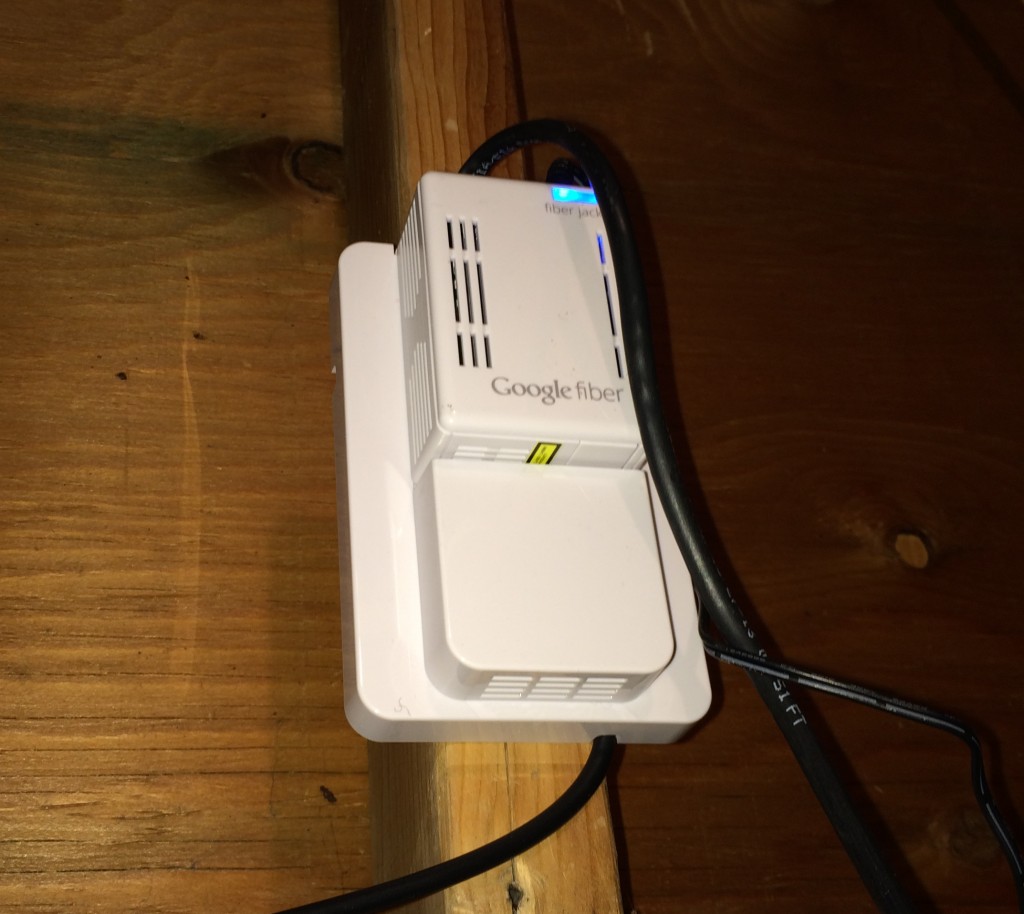 The switch of the Veracity and Google equipment was easily the shortest part of the installation. It took several hours, though, to figure out and then implement a plan to hook up our two TVs and the network box to the fiber, as we didn’t have existing Coax connections within reach of the fiber equipment. The words “worst case scenario” were uttered at one point. There was a lot of head scratching about how best to feed the cable through the various parts of the house to get it where it needed to be. This, too, was a familiar situation from our two FiOS installations (one in Boston and one in New Jersey) – we’ve never had a straightforward installation. Our two guys were soon joined by two others in a second Google Fiber van, and a supervisor also stopped by for a while.
The switch of the Veracity and Google equipment was easily the shortest part of the installation. It took several hours, though, to figure out and then implement a plan to hook up our two TVs and the network box to the fiber, as we didn’t have existing Coax connections within reach of the fiber equipment. The words “worst case scenario” were uttered at one point. There was a lot of head scratching about how best to feed the cable through the various parts of the house to get it where it needed to be. This, too, was a familiar situation from our two FiOS installations (one in Boston and one in New Jersey) – we’ve never had a straightforward installation. Our two guys were soon joined by two others in a second Google Fiber van, and a supervisor also stopped by for a while.
While various technicians were working on running cable through the house and installing various things, the lead technician talked me through all the equipment they’d be leaving behind and how it would work. If you take broadband and TV from Google (which we are), you get two big boxes which sit one on top of the other at some point in your home. The Network box is essentially the router, which takes the Ethernet feed from the fiber box in the basement and makes it available to the rest of the home through WiFi, Coax and Ethernet connections (it has four Ethernet ports). The Storage box sits underneath it and is basically a 2TB hard drive, which is used for DVR storage for the TV. The customer can also upload video, music and pictures to the storage for viewing or listening on the TVs. The dimensions of these boxes are essentially identical, and Google lists them as 7.5″ W x 8″ D x 1.7″ H.
The Network box feeds the two small TV boxes (much smaller than traditional set-top-boxes) which sit next to our two TVs, via coax. The TV boxes have Ethernet jacks which can either feed into the boxes (if coax isn’t possible) or out of the boxes to allow wired connections to other devices such as Roku, Apple TV or Playstations (we have one of ours hooked up to a small switch, which in turn is feeding a Roku and Apple TV as well as an Airport Express). These boxes provide a connection at up to 185Mbit/s to whatever is plugged into them, and can also act as WiFi hotspots / extenders. Google lists the dimensions of this box as 6.8″ W x 5.3″ D x 1.3″ H.
The last item left behind was a Nexus 7 tablet, which is designed to be used as a remote (we already had one, and this one has largely been sitting around gathering dust since the installers left).
Interestingly, the technicians were using a Chromebook with Verizon connectivity to manage the installation. They were running a Google Docs spreadsheet to manage all their jobs for the day, and individual cells were being updated both at our house and back at base as various tasks were completed. Unfortunately, the Chromebook got poor connectivity in the basement while they were doing the installation, and of course our own internet connection was out too. So this was less than optimal in some respects.
Broadband experience
Naturally, the first thing you want to do after having Google Fiber installed is to run a speed test, and the technicians actually run one with you before they leave to make sure it’s up and running. Unfortunately, the TV boxes have to run updates immediately after being plugged in, which hog bandwidth pretty badly and limit the download speeds. We saw about 400Mbit/s during and in the hours after the installation, which was about ten times faster than any connection I’ve had at home, but substantially slower than advertised.
I’ve since returned several times to re-test the network in various configurations, and spent some time this week testing it from various points. Worth noting: I used Google Fiber’s own speed test for these tests, partly because I’ve found other speed tests (including Ookla’s Speedtest.net, which powers Google’s test) can’t handle the high speeds. Here are some of my speed test results.
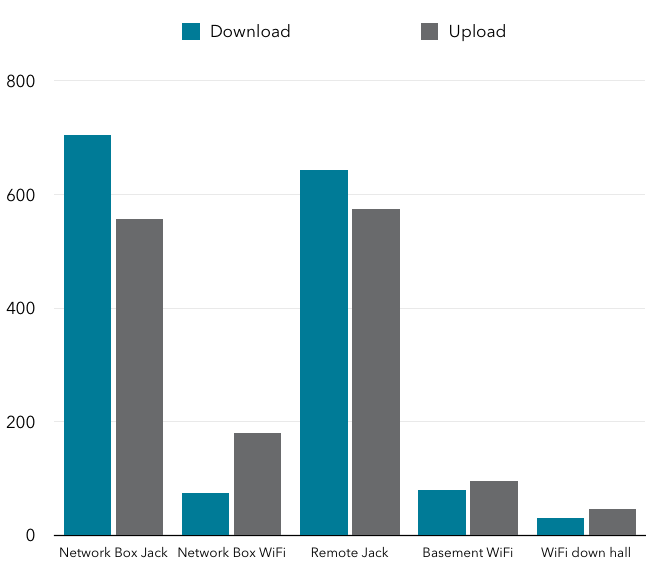 The two key things to note here are: I’ve never got 1Gbit/s out of this thing, and the speed is dramatically less when connected via WiFi. The Network box itself has an Ethernet jack I can plug into, and it also provides WiFi. Connected directly into the jack I got an average of around 700Mbit/s down, and around 550Mbit/s up. This is obviously leagues faster than any other broadband connection I’ve ever had, but it still falls short of the advertised gigabit speeds. It’s worth noting that the TV boxes use the same bandwidth, so if the tuners are on and/or shows are being recorded, that’s going to reduce the total bandwidth available somewhat, and may partially help to explain the sub-gigabit speeds, although it’s extremely unlikely the TV boxes between them are using 300Mbit/s.
The two key things to note here are: I’ve never got 1Gbit/s out of this thing, and the speed is dramatically less when connected via WiFi. The Network box itself has an Ethernet jack I can plug into, and it also provides WiFi. Connected directly into the jack I got an average of around 700Mbit/s down, and around 550Mbit/s up. This is obviously leagues faster than any other broadband connection I’ve ever had, but it still falls short of the advertised gigabit speeds. It’s worth noting that the TV boxes use the same bandwidth, so if the tuners are on and/or shows are being recorded, that’s going to reduce the total bandwidth available somewhat, and may partially help to explain the sub-gigabit speeds, although it’s extremely unlikely the TV boxes between them are using 300Mbit/s.
But the WiFi issue is really the bigger one. Most of us these days have a variety of networked devices in our homes, with many of them being WiFi-first or WiFi-only and with all of them being distributed throughout the home. Smartphones and tablets are WiFi-only, while many laptops are likely never connected to a wired network even if they’re capable of it. As such, almost no matter where your technicians install the network box, many of the devices in the home are going to be connecting via WiFi. Next to the Network Box (which also serves as the WiFi router) I got around 75Mbit/s down, and 180Mbit/s up on average. This is about a tenth of the wired speed for downloads, and about a third of the wired upstream speed. If I go down to my basement, the speed is similar on the download side, but drops by about half on the upstream side.
However, when I merely go down the hallway to my home office, where my computer is connected via WiFi, the connection from the Network Box becomes literally unusable. I still haven’t established whether this is due to simple distance or due to interference from neighbors’ WiFi networks on that side of the house, but having done a bit of testing I’m fairly certain it’s just distance. It’s about 60 feet, so not an enormously long way away, but even though my devices can connect to the WiFi network at that range, nothing actually passes over the connection – browsers and apps all time out every time. If I move a little closer, the connection eventually starts working better, and it improves dramatically as I get significantly closer. The fact is, the Network Box is a lousy router for longer distances, which is perhaps not altogether surprising given that it lacks any sort of external antenna.
I do also have a router of my own, which I immediately hooked up to the Network Box when I discovered this issue. It’s The Wirecutter’s top recommendation, the Asus RT-N66u, which I’ve found to be very good. On that router, I get speeds (which are shown in the chart above as “WiFi down hall”) of around 30Mbit/s down and 45Mbit/s up. That’s pretty ordinary by my standards (having had FiOS in two different homes over the past nine years) and actually very comparable to what I was getting from Veracity before Google Fiber took over the line. This is pretty disappointing when you compare it to the gigabit speeds advertised, and to the speeds I get when hardwired into the router. But that’s the reality of what most people will experience, sitting somewhere in their home, some distance from the Network Box, using WiFi. There’s one big downside to this approach of using your own router rather than the Network Box for WiFi, though, which I’ll cover under TV below.
It’s worth noting that we do have one remote jack near our second TV, which the technicians helpfully installed because they were already putting in a coax jack. At that remote jack, we get the full throughput that we see at the Network Box, which is great. So, for some people that may be a solution, if they’re lucky enough (or willing to pay enough) to get a jack installed somewhere else in the house. We were limited in where we could place the Network Box because the technicians were having to run new wires, but if I’d had a choice I’d have had it installed somewhere different in the house, especially knowing what I know now about the poor WiFi in the Network Box.
What does a gigabit connection actually get you? Given that most of us do fine with much slower speeds, this has always been the biggest question about the utility of Google Fiber: does it actually make any difference? Again, we’ve had fast connections for the last 9 or so years on FiOS and most recently Veracity, so we haven’t experienced the buffering and poor quality some other people do on slower DSL connections. But this is still a significant step up. The fact is, though, that our experience hasn’t changed a great deal – Netflix still works the same way as before, with no obvious difference, even though our Netflix devices are hardwired into the network at up to 185Mbit/s. Websites seem to load at about the same speed as before, and so on.
I did do some testing this week of how big downloads and uploads perform when hardwired into the network, and that did highlight where Google Fiber would make a difference. For downloads, I used iTunes, where I had several movies, TV shows and albums available to download from iCloud, and which provides a download speed in the download dialog. First, I downloaded a couple of HD movies, Monsters University and Moneyball, which are 4.05GB and 3.45GB in size respectively. The iTunes downloads topped out at around 180Mbit/s according to the iTunes download dialog:
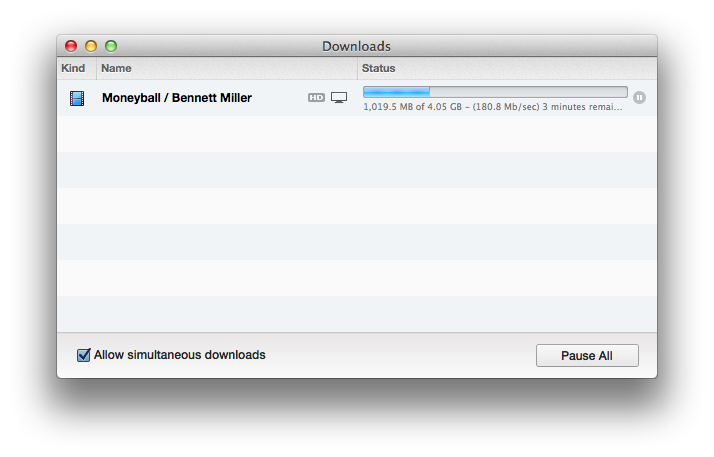 The total download time for these two movies when hard-wired into the Network Box was 3 minutes and 18 seconds for one and 1:27 for the other. The speed was very variable, dropping as low as 50Mbit/s, and occasionally hitting 190Mbit/s. Downloading TV show episodes, which were between 640MB and 660MB in size, took around 34 seconds. An album of songs, roughly 140MB in size, downloaded in about 16 seconds.
The total download time for these two movies when hard-wired into the Network Box was 3 minutes and 18 seconds for one and 1:27 for the other. The speed was very variable, dropping as low as 50Mbit/s, and occasionally hitting 190Mbit/s. Downloading TV show episodes, which were between 640MB and 660MB in size, took around 34 seconds. An album of songs, roughly 140MB in size, downloaded in about 16 seconds.
I also tested uploads, which is less relevant to most people but is certainly relevant if you take a lot of pictures or video and use sites like Vimeo or Flickr to store or share them. Uploading a roughly 1GB video to Vimeo took 2:38, and uploading a set of 62 photos at around 610MB to Flickr took 1:57. All these times are shown in the chart below:
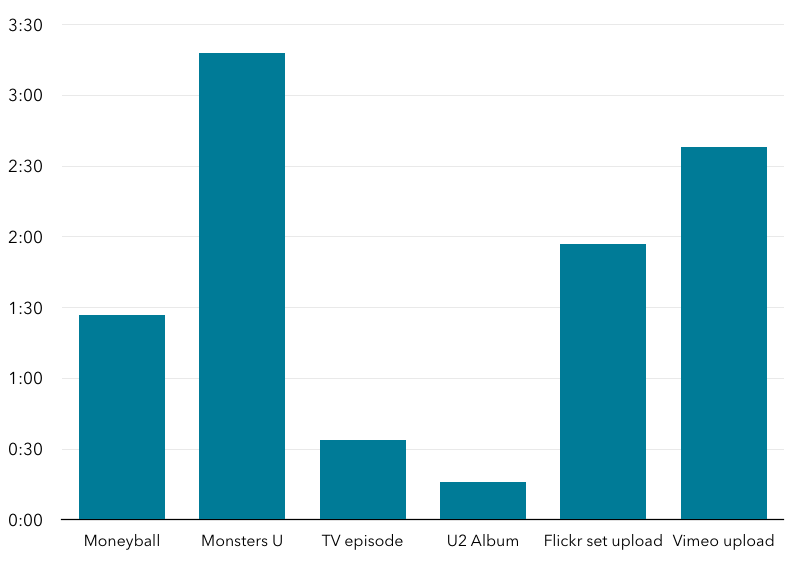 For these files, Google Fiber provides an enormously faster experience than normal broadband, though none of these services operated at anything close to gigabit speeds. iTunes was the only service that provided a speed estimate, and it operated at about a third of my available bandwidth. That’s likely due to a combination of iTunes’ servers not being configured to operate at higher speeds and the fact that I’m some distance away from them, unlike the servers used for the speed tests. But of course all this is dependent on being hard-wired into the network. At my desk, on WiFi, those Flickr and Vimeo uploads took half an hour each, and the movie downloads from iTunes would have taken a similar amount of time.
For these files, Google Fiber provides an enormously faster experience than normal broadband, though none of these services operated at anything close to gigabit speeds. iTunes was the only service that provided a speed estimate, and it operated at about a third of my available bandwidth. That’s likely due to a combination of iTunes’ servers not being configured to operate at higher speeds and the fact that I’m some distance away from them, unlike the servers used for the speed tests. But of course all this is dependent on being hard-wired into the network. At my desk, on WiFi, those Flickr and Vimeo uploads took half an hour each, and the movie downloads from iTunes would have taken a similar amount of time.
All in all, the broadband experience on Google Fiber isn’t particularly life-changing. If you’re hard-wired into it and either uploading or downloading large files, then it makes a huge difference. But the vast majority of my computing and entertainment experience is spent doing things that aren’t particularly bandwidth intensive, and as such it makes little difference so far. In addition, the fact that I’m typically on WiFi (and always on WiFi on my smartphone and tablet) means that I can’t really take advantage of the superior speeds most of the time. I did set up a new laptop this past week, and it was helpful to hook it up to the Network Box directly while it reinstalled apps and downloaded all my files from Dropbox, which would have taken significantly longer over a slower connection (or WiFi) but other than that, I’ve had few reasons to make use of it that justified the hassle of hooking up to a cable.
TV experience
The most striking thing about the Google Fiber TV experience is how un-Googley it is. Given my familiarity with Android, Chrome, Gmail and other Google Apps, I came to the experience with certain expectations of how the interface on the TV might look, but it’s not really all that familiar, and shares few design elements with any of those other Google properties. The basic colors are black, gray, blue and white, with gray the main background color. There’s almost none of the white space that you see in other Google properties these days. The fonts are similar to those used on some of Google’s other properties, but that’s about it. This interface, and the services behind it, seem to have been developed entirely separately from the rest of what Google does. It’s tough to get good screenshots of a TV, but here are some examples of the guide, an information screen and the on-demand menu:
As far as the TV service itself, it seems fine. It has lots of channels including all the usual suspects. The ordering in the guide is somewhat confusing – HD and SD channels seem to sit side by side, often without a clear signal of which is the HD version, which can make setting up DVR recordings of HD shows a challenge at times. The guide is useful, though again the channel names are often not as descriptive as I’d like (you can see examples in the top screenshot above). The interface is generally very fluid, although it occasionally gets stuck for a second or two. It’s pretty quick and responsive, though, even compared to the relatively good FiOS interface I used most recently.
The DVR has some good smart recording options, including how much before and after the official program time you want to start and end recording, which episodes (first-runs or all) you want to record, which channels you want to record the show on, how many you want to keep etc. These will all be fairly familiar options to anyone who’s used a reasonably recent DVR service. There are some clever options such as recording all shows featuring certain actors, which is quite fun, allowing you to set up, for example, a filter for Tom Hanks and record all his shows and movies that play at any time on any channel. With 2TB of space, Google Fiber says there’s room for 500 hours of HD programming on the DVR, which I thought we’d never fill until I set a smart recording option to record all the Winter Olympics coverage on NBC. We were fine for the first few days, but eventually bumped up against the limits of the storage, which caused both TV boxes (which aren’t themselves storing any TV content) to freeze up until I used the smartphone app to delete some items from the DVR. Below is an error message we received on the TV box. Interestingly, you can’t even watch regular live TV until you free up space on the Storage Box, which is a bit odd.
I haven’t been able to figure out whether this was a related issue, but a number of DVR recordings that were scheduled failed to record, with this error message. Given that it happened around the same time the DVR filled up, I suspect it’s related somehow, but it’s not a very helpful error message.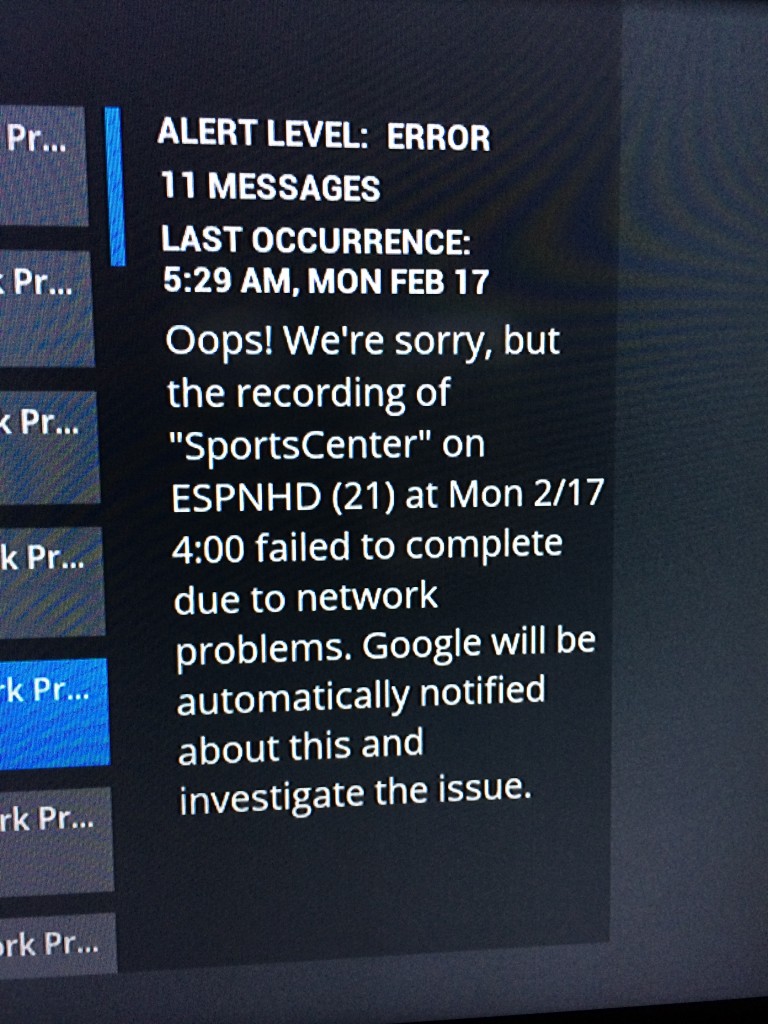 This whole situation highlighted one of the most surprising things about Google Fiber TV: there is no connection whatsoever to the outside world. The only way to manage your TV service, your DVR recordings or anything else is to be inside your home and connected to the same network as the TV boxes are on. From a company that lives online and has a myriad of other cloud-based services, this feels bizarre. And because of the poor WiFi performance of the Network Box which I mentioned above, I’m regularly connected to my own router rather than the Network Box for WiFi, which makes it impossible to manage the DVR and other settings from my smartphone or tablet. Only by switching WiFi networks am I able to log on. This feels like the biggest failing of Google Fiber TV: not being able to manage any of this remotely feels like going back in time, especially given that major telco and cable TV providers have been offering remote DVR access for some time now. Again, it’s a very un-Googley experience.
This whole situation highlighted one of the most surprising things about Google Fiber TV: there is no connection whatsoever to the outside world. The only way to manage your TV service, your DVR recordings or anything else is to be inside your home and connected to the same network as the TV boxes are on. From a company that lives online and has a myriad of other cloud-based services, this feels bizarre. And because of the poor WiFi performance of the Network Box which I mentioned above, I’m regularly connected to my own router rather than the Network Box for WiFi, which makes it impossible to manage the DVR and other settings from my smartphone or tablet. Only by switching WiFi networks am I able to log on. This feels like the biggest failing of Google Fiber TV: not being able to manage any of this remotely feels like going back in time, especially given that major telco and cable TV providers have been offering remote DVR access for some time now. Again, it’s a very un-Googley experience.
There are “apps” on Google Fiber TV, but only very few: essentially, just Netflix and Vudu, with the rest being other apps related to the service itself – see the screenshot below: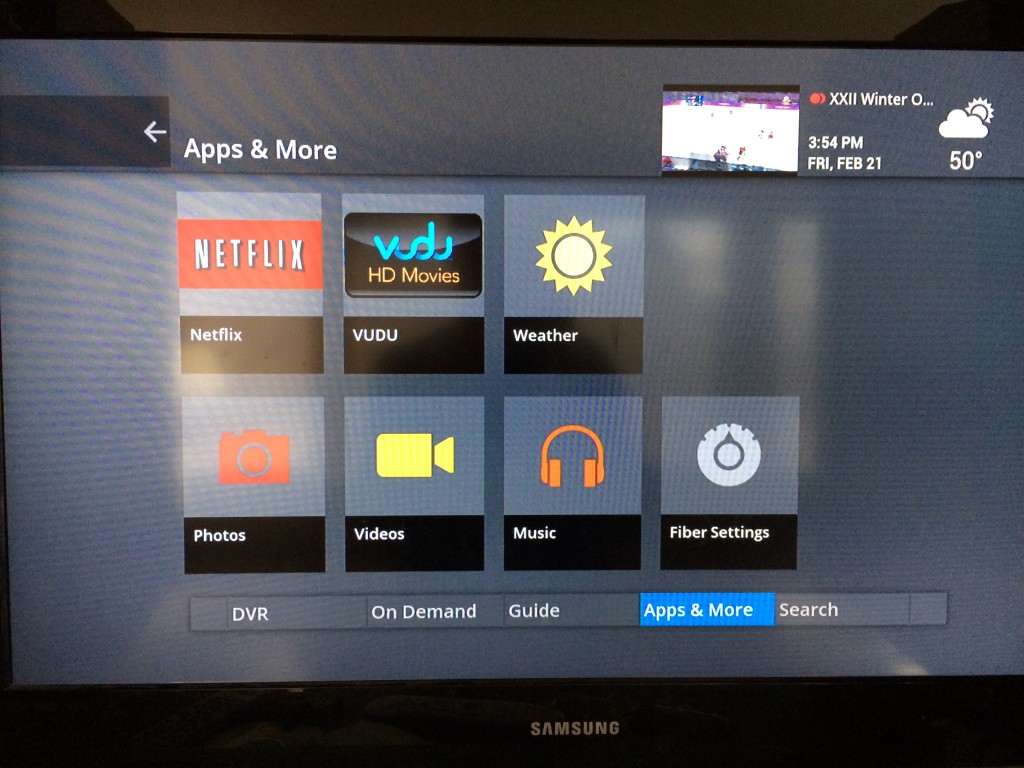 Again, the most amazing part of this is there are zero Google services on offer here, not even YouTube. There’s no Google Play store for video or music, either. I’m not convinced Gmail or Google+ access on the TV would be useful, so those are less glaring omissions. But it really does seem odd that Google is doing so little to tie in its other services to the Google experience. Again, it’s as if this service was developed entirely in isolation from Google’s failed Google TV experiment, which actually had some useful features even though the whole thing flopped.
Again, the most amazing part of this is there are zero Google services on offer here, not even YouTube. There’s no Google Play store for video or music, either. I’m not convinced Gmail or Google+ access on the TV would be useful, so those are less glaring omissions. But it really does seem odd that Google is doing so little to tie in its other services to the Google experience. Again, it’s as if this service was developed entirely in isolation from Google’s failed Google TV experiment, which actually had some useful features even though the whole thing flopped.
Lastly, at a time when many other TV providers offer apps which allow you to watch certain content away from home or on devices other than the TV, the Google Fiber experience is very limited. Yes, it offers the authenticated TV-Everywhere type services offered by other providers such as ESPN and NBC, which is useful. But it’s not quite the same as taking your TV experience with you. Some content is viewable on smartphones and tablets within the home, but very little in the grand scheme of things, and it’s limited by being tied to the same network as the TV boxes. As a funny aside, if you’ve got two-factor authentication enabled on your Google account, and you use the Authenticator app on your smartphone, signing into those authenticated services through ESPN and other apps on your smartphone is an exercise in frustration!
Voice
One thing I haven’t mentioned yet is that Google Fiber doesn’t include any sort of voice service, at least here in Provo. This means that anyone who still wants a landline has to procure it separately. If you want to use VoIP services like Vonage, you’re locked into wherever your wired connections are – likely, the Network Box and if you’re lucky one other jack somewhere in the house, and it’s quite unlikely either of those is where you want your phone. We procured basic voice service from Veracity just to maintain a number previously associated with the house, but the phone has to be plugged directly into an ATA, which in turn is plugged directly into the Network Box. I suspect all this is because Google didn’t want the additional regulatory legwork associated with running a telephony service, but it’s pretty inconvenient from a user perspective.
Final thoughts
All in all, it’s been an interesting experience. I’ve always been a bandwidth junkie, getting the fastest broadband connection available at a reasonable price wherever we’ve lived, which has included several 40Mbit/s plus services in the past, including the fiber-based connection we had here before Google Fiber was installed. As such, I was excited for Google Fiber to be installed, and imagined it would be a really fun experience. But the reality is that the benefits of Google Fiber from a bandwidth perspective are largely limited to those devices that can be wired directly into the network or which will stay within about 20 feet of the network box. As such, it’s been a bit of a letdown in terms of changing the everyday experience. Most things feel very much the same as they were before, and it’s only the occasional opportunity to plug in for super-fast speeds that provides that thrill of high bandwidth.
The TV experience is utterly fine for the basics, and has some clever features (including a nifty search function that allows you to use the numeric keypad on the very standard-looking remote), but it’s surprisingly free of the sort of value-add you’d expect Google to provide. There’s no remote access for any of the TV features, there are no Google services on the TV, and the whole interface is quite different from other Google services. Again, the overwhelming impression is that this was developed in a silo far away from the rest of Google.
The question then becomes, how much will Google Fiber achieve either the objectives Google has for it, and the aspirations others have for it? In Austin, Google Fiber’s arrival has prompted AT&T to do a significant upgrade, and it now looks as if Time Warner Cable will attempt to match AT&T’s interim speeds of 300Mbit/s. So in that sense, Google’s assumed objective of driving other providers to increase speeds has been moderately successful, though we haven’t seen similar moves from incumbent providers in either Kansas City or here in Provo. And there’s no evidence that any of these providers will spread these efforts beyond those areas where they feel directly threatened by Google Fiber. So the impact is limited.
As for Google’s objectives of seeing what’s possible when people have faster connections, I’ve argued from the beginning that Google Fiber will have a limited impact as long as it’s being rolled out in individual cities, with a very small overall population of users. For all Google’s talk about doctors communicating with patients over HD video and such, there’s little evidence any of this sort of thing is actually happening in practice in any of the Google Fiber cities. And it’s unlikely that broader changes will be brought about as long as the footprint is so limited. Perhaps Google’s announced expansion to 34 additional cities is a recognition of this fact, and that might have more impact in time.
Lastly, Google is doing little to foster interest in its other services, or greater access to them, since most of them function just fine on slower connections, and there’s no integration with other Google services anywhere in Google Fiber.
It’s possible that Google will eventually make enough money from Google Fiber to prompt it to roll it out very widely, but I’m still skeptical that that will ever happen. The 34 cities in the latest announcements are, like those already rolled out, likely outliers rather than being typical of most of the country, as Google cherry-picks locations where the economics, topography and regulatory environments make a rollout feasible. The larger Google’s footprint gets, the more likely it is that it will have to deal with regulation which would make the economics and logistics of rolling out more fiber more like those of legacy providers, which will probably cause a dramatic slowdown in this activity.
For now, I think Google Fiber will remain an interesting experiment. If it can solve the WiFi issues I’ve seen, it may provide greater benefits than it does today, so that should be at the top of its to-do list. But most users won’t see their lives dramatically changed by it, and I’d say that’s a useful counterpoint to the clamoring for more bandwidth that we’ve seen over the last few years, and to some extent a validation of the slow-and-steady approach we’ve seen from incumbent cable and telco broadband providers.
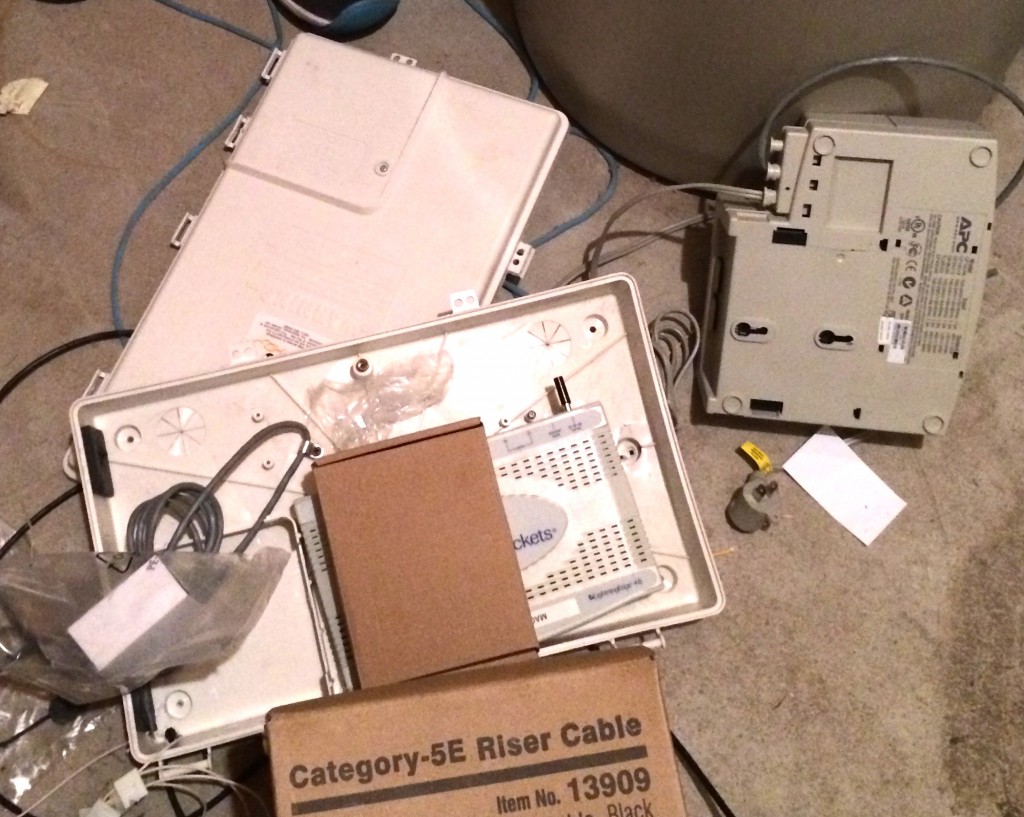
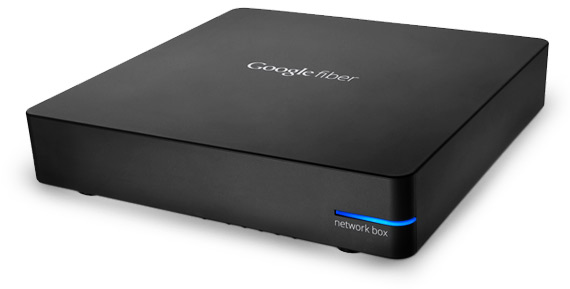
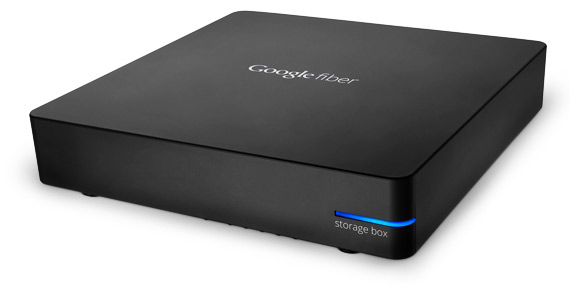
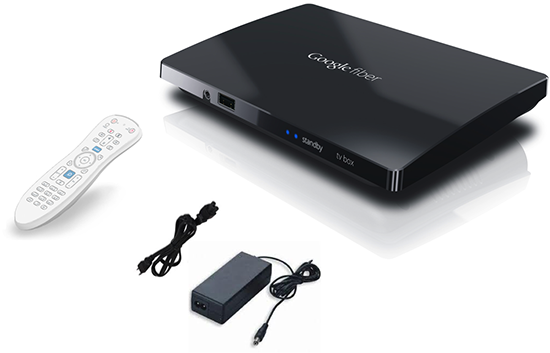
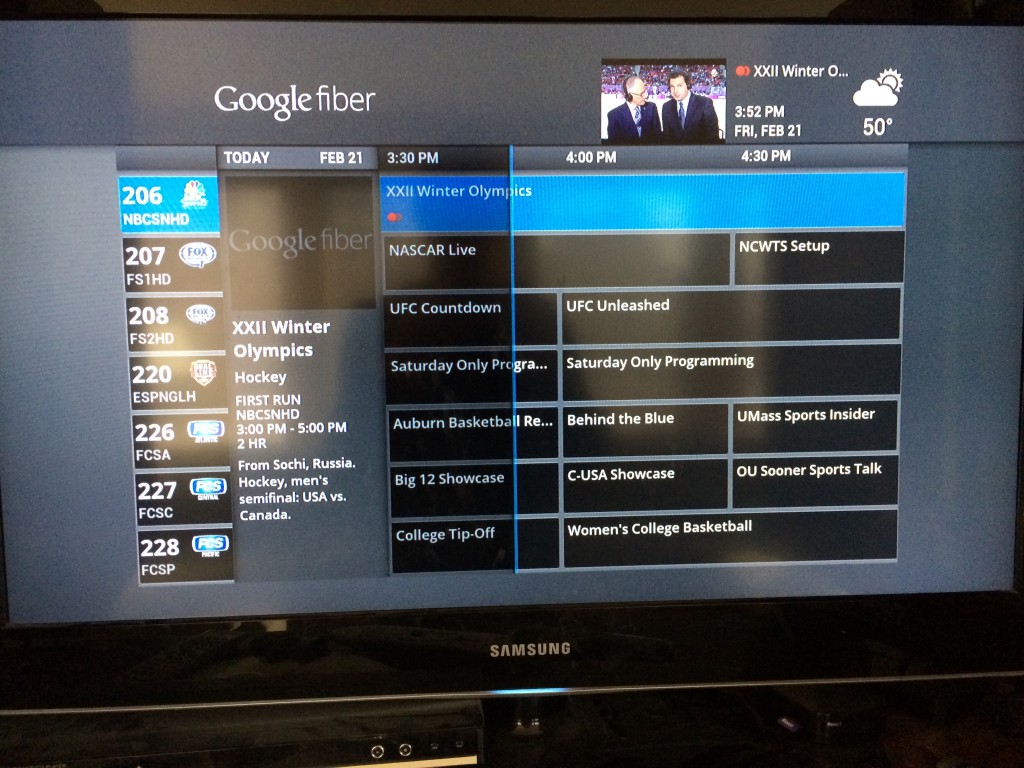
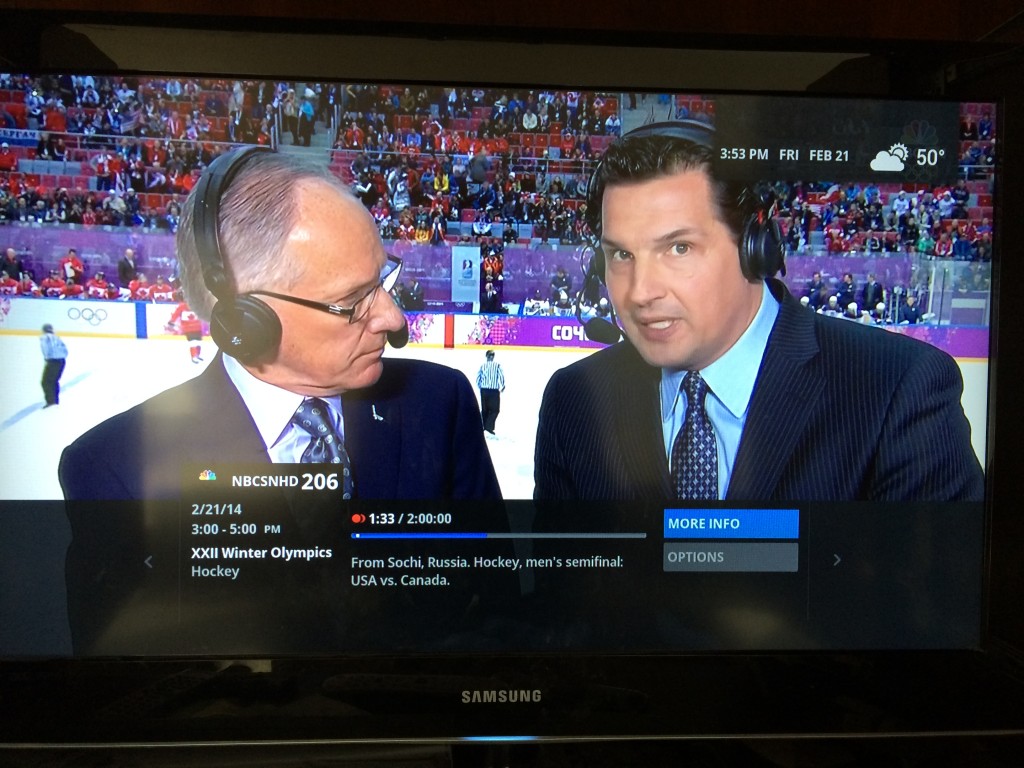
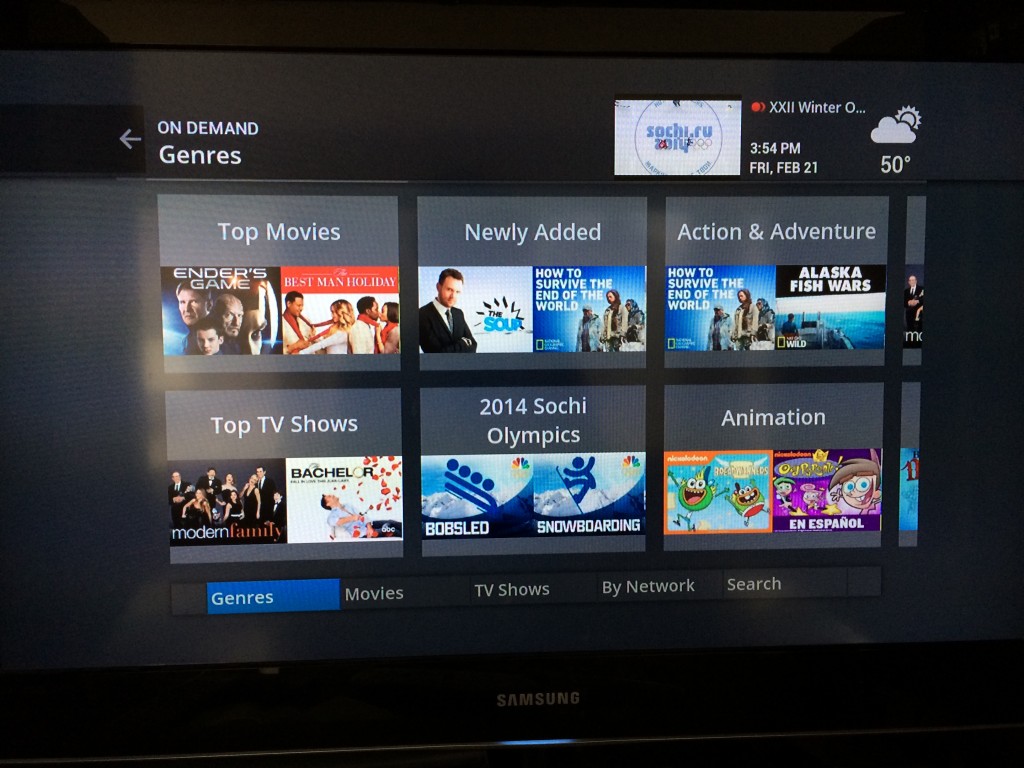
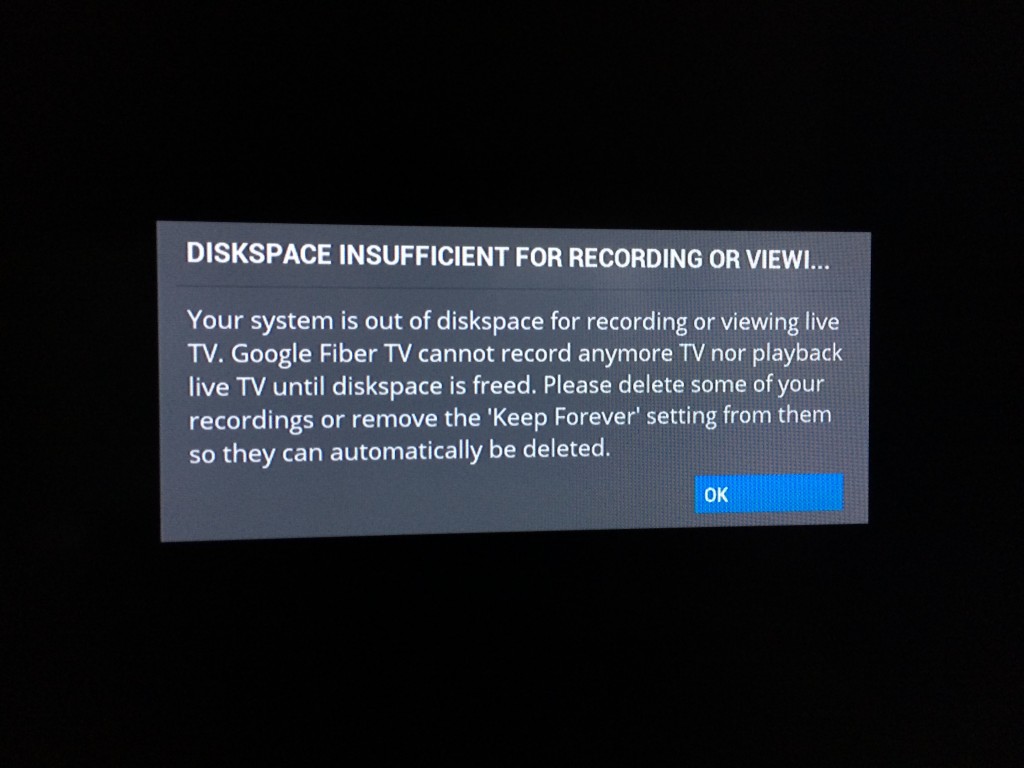
Pingback: Thoughts on Google Fiber, from a user | Beyond Devices()